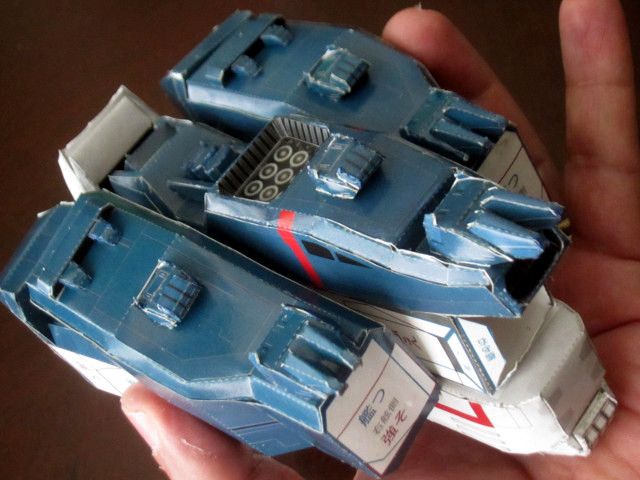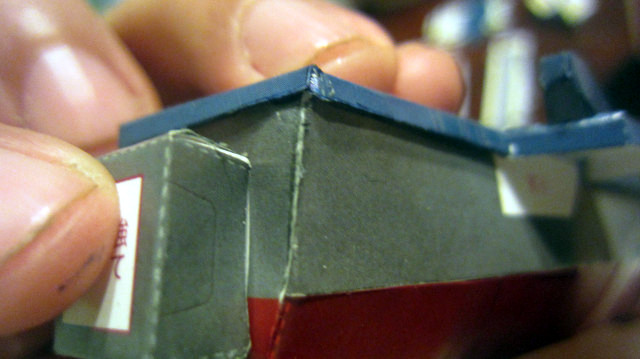
So I got lucky and scored a Robotech Factory at an antique store here in the middle of nowhere for dirt cheap. And like the first time I saw Minmay's butt in the fourth episode of the original Macross cartoon, my life has been constant anxiety and excitement ever since. It's like getting kissed or married or having a kid or all those other crazy life changing things that define new eras of your time. There was my life before the coming of Robotech Factory and now I live in the post Robtoech Factory excitement period. I am obsessed. Every minute I am away from Robotech Factory seems like wasted time. Whatever I am doing I constantly weigh against what fun I could be having just staring at Robotech Factory's box. I can't stop thinking about this gift, this huge honor bestowed upon me by the Robotech Fairy for only 26 bucks. Why was I chosen? And more importantly, just what is the Robotech Factory anyway?

AS A MATTER OF FACTORY...
This model and other Macross dioramas was originally released by Japanese modelmaker Imai before bankruptcy forced them to sell off their tooling to Bandai. Its original release called the Macross Factory included one hangar, fifteen crew members, three trucks and no robots. Then Imai released a super deluxe version with twice the same parts plus two robots-the armored VF-1A and a Destroid Tomahawk. This double hangar version was called the Armored Factory in Japan and the Robotech Factory when released in North America by Revell. (The 1985 Revell Product Catalog actually calls it 'Robot Factory' but the packaging drops 'robot' and implies the name is 'Robotech Factory'.)

'Robot Factory' from page 100 of the 1985 Revell Product Catalog
STICKIN' TO THE FACTORIES
The Robotech Factory is a straight up repackaging of the Armored Factory down to the IMAI stampings on the rear of the hangar walls. Bandai rereleased the set thirty years later in 2012 but with Bandai stampings on the bases and slightly different colored plastic . The Revell release could be had cheap because it went clearance shortly after release (see the comment section of this post). Both the Imai and Revell version became quite expensive on the secondary market before the Bandai reissue, with sellers usually asking in the range of $200+ as late as 2009 according to some message boards I've seen. (This guy wants $400 for his built one.) After the reissue, prices came down a bit and some sellers have them even today for as little as 50 bucks plus shipping. Still, for me to find the Robotech version for under 30 dollars was pretty unusual.

PARTS PARTY
The Robotech Factory kit is intimidating in its size and parts count. It's a little over 430 pieces in six different colors plus a bag of chains. I say 'a little over' because after counting 430 parts I began getting confused as to what exactly constitutes an individual part. But if you realize that this is actually several distinct robots, people, vehicles and pieces of equipment it begins to become a little less overwhelming. Since most of it is actually the same hangar twice, it's actually easier to process than if all the parts were unique and part of one singular whole. I'd say this is just as easy as building one 200 piece model plus a robot, and then doing that twice. Except at the same time. Well you know what I mean.
 |  |
|---|
FACTORY UNSPECIFIC
With an idea of what it was and where it came form in real life, I wanted to figure out where the Factory fit in the Macross fiction. Was it supposed to depict a place on earth where Destroids and Valkyries were made before the Macross was completed? Was it somewhere inside the SDF-1? Were there any scenes during the show where this specific backdrop appeared? Well I looked and couldn't find any. There are a couple of shots with general elements of the Factory like hangars, multi level staircases, overhead cranes, robots on roller platforms, and boom lift trucks but the entire diorama doesn't show up exactly with all of the elements together at once anywhere in Macross. The only illustration where it all comes together in colors close to what the parts are molded in or what the instructions say to paint them as is on the cover of the Armored Factory box. This lack of specific canonical reference is good because it gives modelers artistic license to do whatever they want in terms of colors. But it's also bad because it gives modelers artistic license to do whatever they want in terms of colors. Not having a solid reference drives me crazy!

MY FIVE FAVORITE FACTORIES
In the absence of canon fictional reference I went looking online for existing builds of the Factory to see what other people have done with it. The build showcased for the 2012 reissue was painted quite impressively, but what did the actual hobbyists do? Would they leave it unpainted? Stick to the recommended colors as outlined in the instructions? Would they try to do something show specific? Or would they try to recreate the industrial waste factory at the end of Robocop? You can play along using your favorite image search engine with the katakana for Macross "マクロス", Armored "アーマード", and Factory "ファクトリー". (I don't think they make katakana for 'Robotech'.)
| Super clean paint on this one and some really nice photography. |  |
|---|---|
| My favorite. I especially love his trucks. |  |
| They went with green hangar doors on this one plus there's a 1/100 painted as Jetfire! (scroll down till you see Minmay) |  |
| Sort of a minimalist build of the reissue, but nice. |  |
| MORE LIKE ROBOCOP FACTORY AMIRITE? |  |

















































































